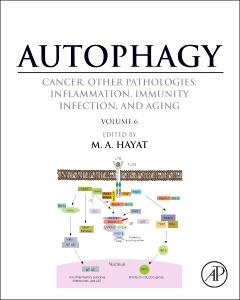Description
Autophagy: Cancer, Other Pathologies, Inflammation, Immunity, Infection, and Aging
Volume 6- Regulation of Autophagy and Selective Autophagy
Coordinator: Hayat M. A.
Language: English
Subject for Autophagy: Cancer, Other Pathologies, Inflammation...:
Keywords
mechanism; regulation; intracellular; pathogen; host; immunity; selective; protein; degradation; repurpose; antigen
338 p. · 19x23.3 cm · Hardback
Description
/li>Contents
/li>Readership
/li>Biography
/li>Comment
/li>
Volume 6 provides coverage of the mechanisms of regulation of autophagy; intracellular pathogen use of the autophagy mechanism; the role of autophagy in host immunity; and selective autophagy. Attention is given to a number of mechanistic advances in the understanding of regulation, particularly the importance of nutrient availability; microRNAs; and cross-talk with other protein degradation pathways. Intracellular pathogen repurposing of autophagy for pathogenic benefit is also provided, with coverage of Herpesvirus protein modulation of autophagy; the varicella-zoster virus and the maintenance of homeostasis; and the relationship between autophagy and the hepatitis b virus.
The significance of autophagy in host defense is elucidated, providing a specific focus on facilitation of antigen presentation; participation in thymic development; and the sharing of regulatory nodes with innate immunity. Selective autophagy for the degradation of mitochondria and endocytosed gap junctions are also explored.
This book is an asset to newcomers as a concise overview of the regulation of autophagy, its role in host defense and immunity, and selective autophagy, while serving as an excellent reference for more experienced scientists and clinicians looking to update their knowledge.
Volumes in the Series
Volume 1: Molecular Mechanisms. Elucidates autophagy?s association with numerous biological processes, including cellular development and differentiation, cancer, immunity, infectious diseases, inflammation, maintenance of homeostasis, response to cellular stress, and degenerative diseases such as Alzheimer?s, Parkinson's, Huntington's, amyotrophic lateral sclerosis, and prion diseases. Volume 2: Role in General Diseases. Describes the various aspects of the complex process of autophagy in a myriad of devastating human diseases, expanding from a discussion of essential autophagic functions into the role of autophagy in proteins, pathogens, immunity, and general diseases. Volume 3: Role in Specific Diseases. Explores the role of autophagy in specific diseases and developments, including: Crohn?s Disease, Gaucher Disease, Huntington?s Disease, HCV infection, osteoarthritis, and liver injury, with a full section devoted to in-depth exploration of autophagy in tumor development and cancer, as well as the relationship between autophagy and apoptosis.Volume 4: Mitophagy. Presents detailed information on the role of mitophagy, the selective autophagy of mitochondria, in health and disease, by delivering an in-depth treatment of the molecular mechanisms involved in mitophagy initiation and execution, as well as the role of mitophagy in Parkinson Disease, cardiac aging, and skeletal muscle atrophy. Volume 5: Role in Human Diseases. Comprehensively describes the role of autophagy in human diseases, delivering coverage of the antitumor and protumor roles of autophagy; the therapeutic inhibition of autophagy in cancer; and the duality of autophagy?s effects in various cardiovascular, metabolic, and neurodegenerative disorders.Volume 6: Regulation of Autophagy and Selective Autophagy. Provides coverage of the mechanisms of regulation of autophagy; intracellular pathogen use of the autophagy mechanism; the role of autophagy in host immunity; and selective autophagy. Volume 7: Role of Autophagy in Therapeutic Applications. Provides coverage of the latest developments in autophagosome biogenesis and regulation; the role of autophagy in protein quality control; the role of autophagy in apoptosis; autophagy in the cardiovascular system; and the relationships between autophagy and lifestyle. Volume 8: Autophagy and Human Diseases. Reviews recent advancements in the molecular mechanisms underlying a large number of genetic and epigenetic diseases and abnormalities, and introduces new, more effective therapeutic strategies, in the development of targeted drugs and programmed cell death, providing information that will aid on preventing detrimental inflammation.Volume 9: Necrosis and Inflammation in Human Diseases. Emphasizes the role of Autophagy in necrosis and inflammation, explaining in detail the molecular mechanism(s) underlying the formation of autophagosomes, including the progression of Omegasomes to autophagosomes.
Academic/clinical professors, post-doctoral fellows, graduate and medical students in immunology, pathology, infectious diseases, cancer research, oncology, pathology, biology, bioinformatics, endocrinology, gastroenterology, reproductive oncology and public health, industries in drugs development
- Bings together a wide swathe of experts (oncologists, neurosurgeons, physicians, research scientists, and pathologists) in the field of autophagy to discuss recent developments in this rapidly-advancing field
- Discuses role of autophagy in immunity, with coverage of toll-like receptors as activators for autophagy; role in antigen processing; and control of production and secretion of il-1B
- Covers role of autophagy receptors in mitophagy; role of parkin and pink1 in mitochondrial quality control; and the degradation of endocytosed gap junctions
- Organized for readers into easy-to-access sections: autophagy and molecular mechanisms; autophagy and intracellular pathogens; autophagy and immunity; and general applications




